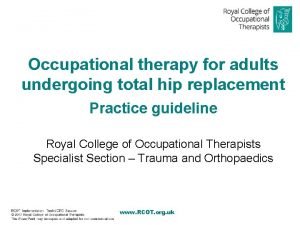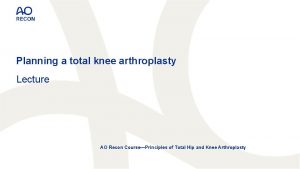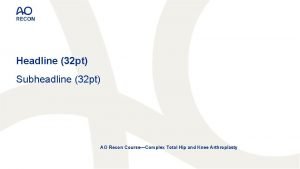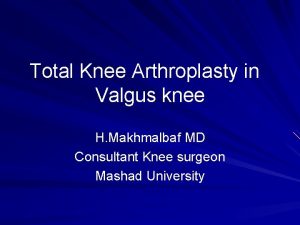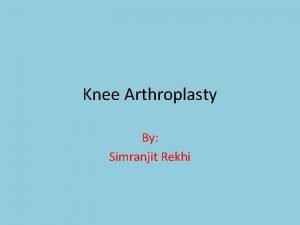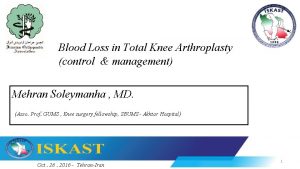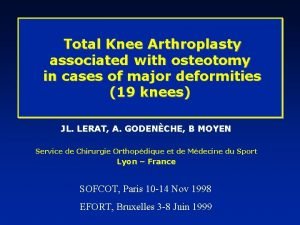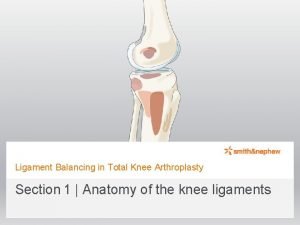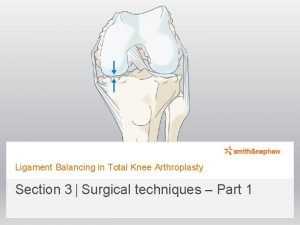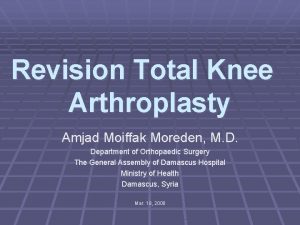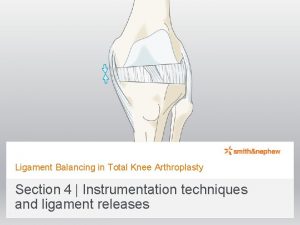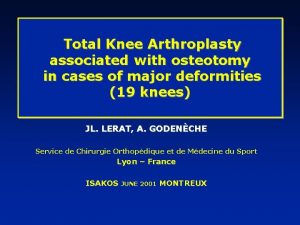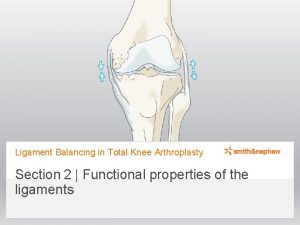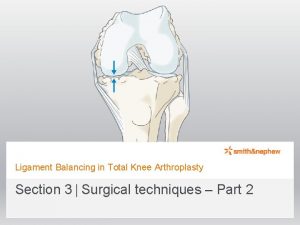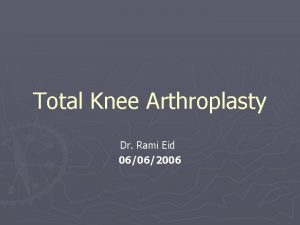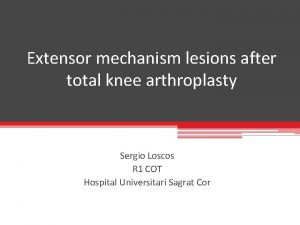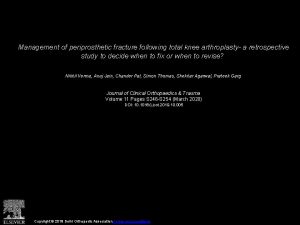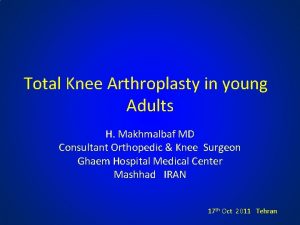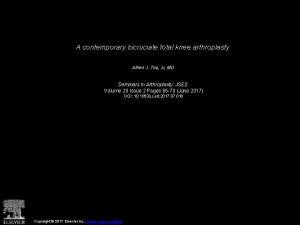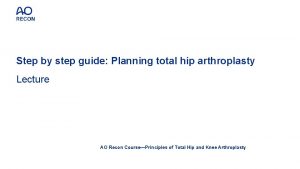Planning a total knee arthroplasty Lecture AO Recon






















- Slides: 22

Planning a total knee arthroplasty Lecture AO Recon Course—Principles of Total Hip and Knee Arthroplasty

Disclosure 2

Learning objectives • • Describe the principles of alignment Describe the x-ray views to obtain Recognize deformities/malalignment Describe the steps in a total knee arthroplasty (TKA) templating 3

Gold standard? 90° 4 90° - 95°

Anatomical alignment • Goal: tibial cut with 3°varus = medial slope • Why 3°medial slope at the tibia? 5

Gait cycle Standing on both legs 6 Weight bearing: centering of the leg under the upper body

Which x-rays? Is appropriate planning possible? 7

Which x-rays? Navigation/PSI Full-length hip-to-ankle AP weight-bearing view 8

Which x-rays? • Evaluation of ligaments? AP stress view • Unicondylar vs bicondylar knee replacement Beaufils et al 9

Which x-rays? Rosenberg view Melnic et al (J Orthopedics Rheumatol, 2014; 2(1): 6) 10

Which x-rays? Rosenberg view Melnic et al (J Orthopedics Rheumatol, 2014; 2(1): 6) 11

Which x-rays? Patella 12

Which x-rays? Patella 13

Which x-rays? • Important for planning and choice of implant design • Varus-valgus constrained: • Linked femoral and tibial components (hinged) • Prosthesis allows rotational stability 14

Deformity—intraarticular Correction with bone resection 15

Deformity—extraarticular No correction possible with a bone resection ligament instability 16

Deformity—extraarticular No correction possible with a bone resection ligament instability 1. Osteotomy with Center of Rotation and Angulation (CORA) method 2. TKA implantation: 1 - or 2 -stage procedure 17

Preoperative planning? 1. Cutting plane 2. Femoral valgus cut angle 3. Femoral entry point 18

Preoperative planning? 1. 2. 3. 4. 19 Cutting plane Femoral valgus cut angle Femoral entry point Tibial slope (posterior-cruciate retaining vs posterior-stabilized)

Preoperative planning? 1. 2. 3. 4. Cutting plane Femoral valgus cut angle Femoral entry point Tibial slope (posterior-cruciate retaining vs posterior-stabilized) 5. Implant size 20

Take-home messages • Anatomical alignment: • 3° tibial varus cut = medial slope • X-ray views: • Full-length hip-to-ankle AP weight-bearing view • AP stress view • Patella view • Rosenberg view • Extraarticular deformity: no correction possible with bone resection CORA method 21

Planning a total knee arthroplasty Lecture
 Arthroplasty practitioner
Arthroplasty practitioner Occupational therapy hip replacement interventions
Occupational therapy hip replacement interventions Ao recon
Ao recon Knee replacement before and after pictures
Knee replacement before and after pictures Fi recon tat lapsed meaning
Fi recon tat lapsed meaning Internal recon
Internal recon Passive recon
Passive recon Http //ringkas.kemdikbud.go.id/recon
Http //ringkas.kemdikbud.go.id/recon Linprivchecker
Linprivchecker Ao recon course
Ao recon course 01:640:244 lecture notes - lecture 15: plat, idah, farad
01:640:244 lecture notes - lecture 15: plat, idah, farad Formula de roe
Formula de roe Total revenues minus total costs equals
Total revenues minus total costs equals Total revenues minus total costs equals
Total revenues minus total costs equals Total revenues minus total costs equals
Total revenues minus total costs equals Total revenue minus total expenses
Total revenue minus total expenses Land use planning lecture notes
Land use planning lecture notes Land economics lecture notes
Land economics lecture notes Land use planning '' lecture notes
Land use planning '' lecture notes Contemporary management theory ppt
Contemporary management theory ppt Project planning and management lecture notes ppt
Project planning and management lecture notes ppt Total order planning in artificial intelligence
Total order planning in artificial intelligence Strategic planning vs tactical planning
Strategic planning vs tactical planning

